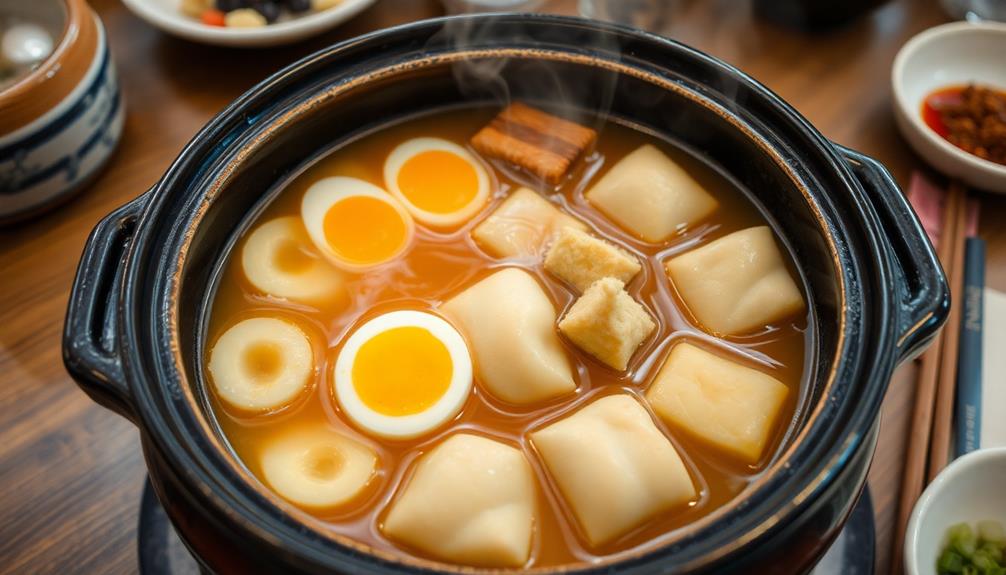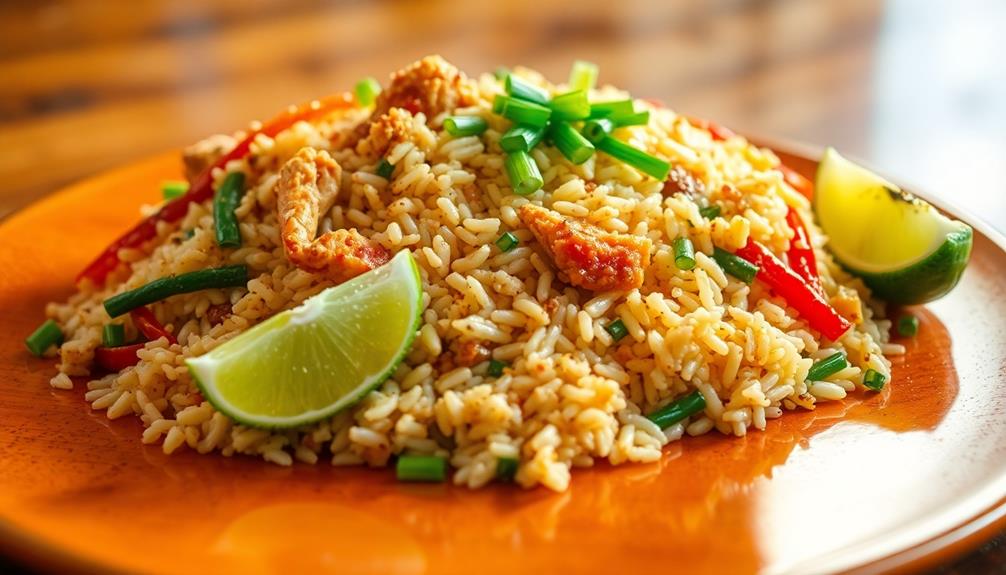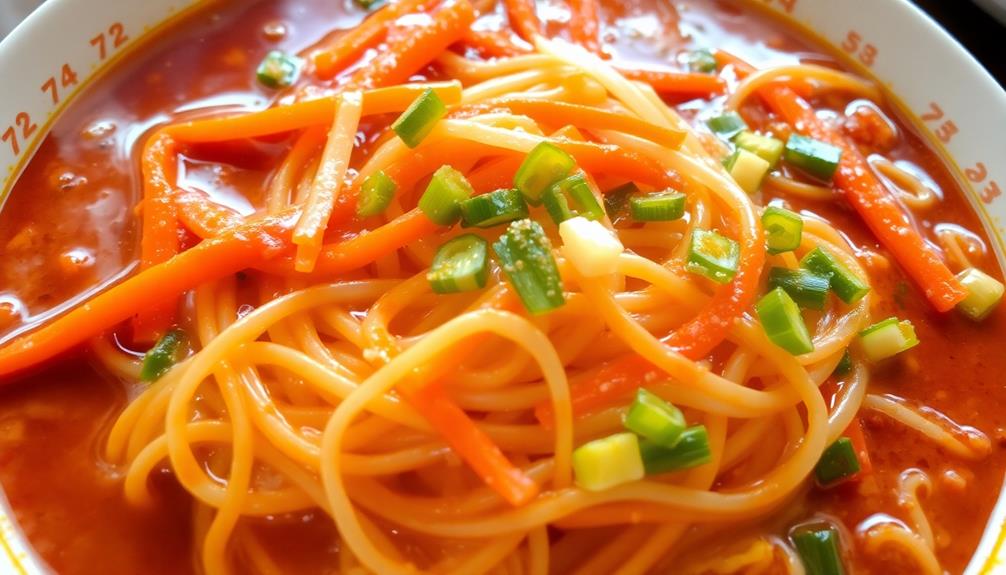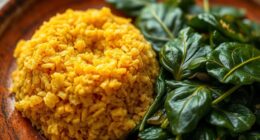Rendang, the beloved spicy meat stew, hails from the Minangkabau region of Indonesia. It's a dish with a rich history, going back to the 16th century when the Minangkabau people developed a way to preserve meat by cooking it with spices and coconut milk. Over time, the recipe has evolved, with different regions adding their own unique twists using local ingredients. Today, rendang is a signature dish in Malaysian cuisine, representing the culinary heritage of both Malaysia and Indonesia. It's often enjoyed during festive gatherings, symbolizing hospitality and generosity. But there's more to discover about this flavorful dish…
Key Takeaways
- Rendang is a traditional Indonesian beef stew known for its rich, fragrant, and tender meat with a curry-like consistency, developed through a long, slow cooking process.
- The dish originates from the Minangkabau people of West Sumatra and has become a signature dish representing the culinary heritage of both Malaysia and Indonesia.
- Key ingredients include beef, coconut milk, lemongrass, kaffir lime leaves, and a blend of spices like coriander, cumin, and turmeric, which reflect the diverse agricultural produce of Southeast Asia.
- The cooking process involves browning the meat, simmering it in coconut milk, and gradually reducing the liquid to achieve a thick, velvety sauce, with the final product often garnished with toasted coconut.
- Rendang is typically served during special occasions and celebrations, enjoyed in various settings from street food stalls to fine dining, and is often accompanied by steamed rice and side dishes.
History
Rendang's history can be traced back to the Minangkabau people of West Sumatra, Indonesia. This delicious dish has been a beloved part of their culture for centuries.
The origins of rendang can be traced to the 16th century, when the Minangkabau people developed a way to preserve meat by cooking it in a blend of spices and coconut milk.
Over time, the recipe evolved, with different regions putting their own unique spin on the dish. Today, rendang is enjoyed across Indonesia and has even become a beloved dish in many other parts of the world.
Its rich, complex flavors and tender, succulent meat make it a true culinary delight.
Whether you're a longtime fan of rendang or are just discovering it for the first time, there's no denying its rich history and the passion that goes into every bite.
Recipe
Rendang is a beloved Indonesian dish that originated from the Minangkabau ethnic group in West Sumatra. This flavorful curry-like dish is typically made with beef, although it can also be prepared with chicken, lamb, or even vegetables. The unique blend of spices, slow cooking, and the resulting caramelized flavors make rendang a true culinary delight.
Rendang is a dish that requires patience and attention to detail. The slow-cooking process, which can take several hours, is what transforms the tough cuts of meat into melt-in-your-mouth tenderness. The key is to allow the flavors to meld and the sauce to reduce, creating a rich, thick, and intensely flavored dish.
Ingredients:
- 2 lbs beef (such as chuck or brisket), cut into 1-inch cubes
- 1 cup coconut milk
- 1/2 cup water
- 3 lemongrass stalks, bruised
- 3 kaffir lime leaves
- 2 inches galangal, sliced
- 2 inches ginger, sliced
- 5 cloves garlic, minced
- 2 shallots, sliced
- 2 red chilies, sliced (or 1 tsp chili powder)
- 2 tsp ground coriander
- 1 tsp ground cumin
- 1 tsp ground turmeric
- 1 tsp salt
- 1 tsp brown sugar
- 2 tbsp coconut oil
Cooking Instructions:
In a large pot or Dutch oven, heat the coconut oil over medium-high heat. Add the lemongrass, lime leaves, galangal, ginger, garlic, shallots, and chilies. Sauté for 2-3 minutes until fragrant.
Add the beef and brown it on all sides, about 5-7 minutes. Pour in the coconut milk and water, then stir in the ground coriander, cumin, turmeric, salt, and brown sugar. Bring the mixture to a boil, then reduce the heat to low, cover, and simmer for 2-3 hours, stirring occasionally, until the beef is very tender and the sauce has thickened.
Tips:
For best results, use a combination of beef cuts, such as chuck and brisket, to achieve the perfect balance of tenderness and flavor.
Additionally, be patient and allow the rendang to simmer for the full 2-3 hours to ensure the meat is fork-tender and the sauce has developed its signature rich, caramelized taste.
Serve the rendang with steamed rice, and enjoy the complex and delicious flavors of this iconic Indonesian dish.
Cooking Steps
Alright, let's get cooking!
First, you'll need to prep your spices for the rendang.
Then, brown that meat to perfection.
Next, you'll simmer the meat in rich coconut milk until it's oh-so-tender.
Finally, reduce the liquid down until it's thick and creamy, and top it off with some toasted coconut for a little crunch.
Get ready for an incredible flavor explosion!
Step 1. Prepare Spices for Rendang
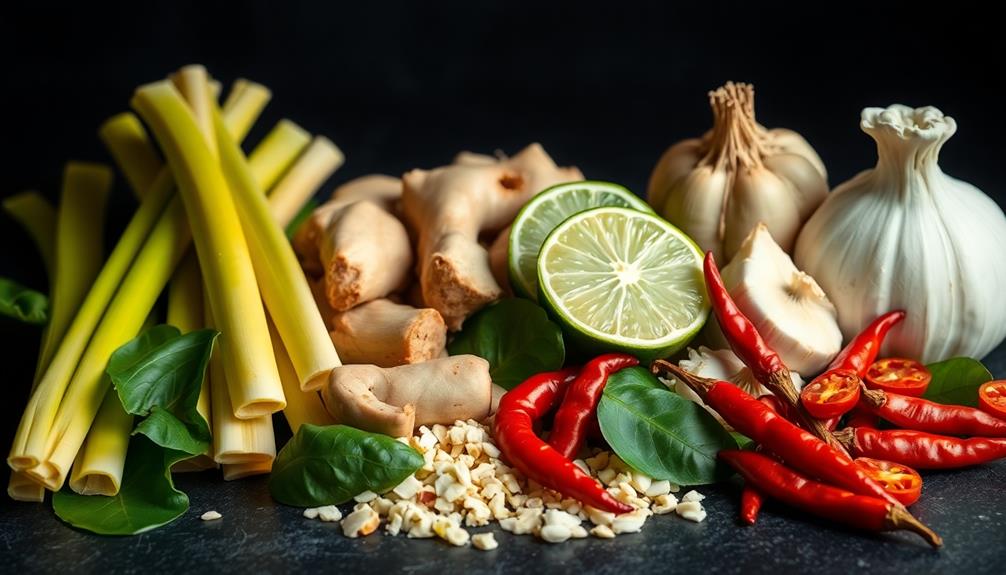
Preparing the spice blend is a crucial step in crafting an authentic rendang. Start by gathering a mortar and pestle or a small food processor. In the mortar, combine fragrant spices like coriander, cumin, and fennel seeds. Crush them into a fine powder, releasing their aromatic oils.
Next, add some dried chilies, peeled garlic cloves, and shallots. Pound everything together until you have a smooth, fragrant paste. Once you have achieved a smooth, fragrant paste, you are well on your way to having a delicious homemade sambal recipe. The combination of dried chilies, garlic, and shallots will give the sambal a spicy and aromatic flavor that is perfect for adding a kick to any dish. With just a few more ingredients, you will have a flavorful condiment that can be used in a variety of dishes.
Don't forget the lemongrass! Trim the tough outer leaves, then thinly slice the tender inner portion. Add the lemongrass to the spice blend and give it a few more good pounds. This will help release the citrusy, floral notes that are essential for rendang.
Step 2. Brown the Meat
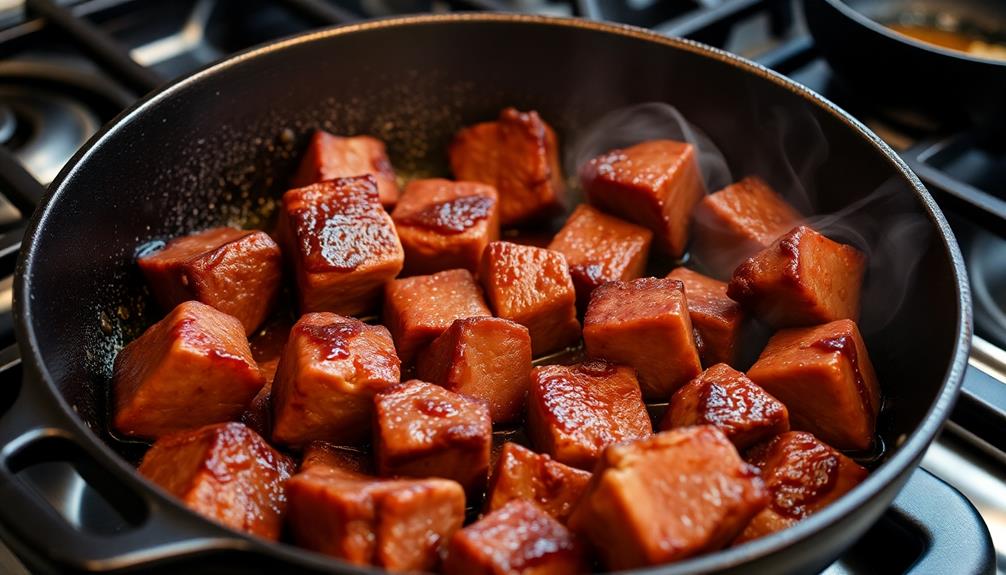
With your spice blend ready, it's time to brown the meat.
Heat a large, heavy-bottomed pan or Dutch oven over medium-high heat. Once the pan is hot, add a bit of oil. Carefully place the beef cubes into the pan, making sure not to overcrowd them. You want to give the meat enough space to sear and brown properly.
As the meat sizzles, let it cook undisturbed for a couple of minutes. This allows a nice, caramelized crust to form on the exterior. Once the bottom sides are nicely browned, use tongs to flip the pieces over and brown the other sides. Work in batches if needed to avoid overcrowding.
The goal is to get a rich, deep color on the meat without cooking it all the way through. This browning step adds fantastic flavor to the rendang.
Once all the meat is browned, you're ready to move on to the next step of the cooking process.
Step 3. Simmer Meat in Coconut Milk

Next, you'll add the browned beef to the pot with the coconut milk. Gently pour in the rich, creamy coconut milk, making sure to scrape up all the flavorful bits from the bottom of the pan. This coconut milk will help tenderize the meat and infuse it with a delightful tropical flavor.
Now, let the mixture simmer gently over medium-low heat. As it bubbles away, the flavors will meld and the meat will become deliciously tender.
Be sure to stir the pot occasionally to prevent anything from sticking. Over time, the coconut milk will thicken and create a luxurious sauce that coats the beef perfectly.
Keep a close eye on the pot, adjusting the heat as needed to maintain a gentle simmer. This slow simmering process is essential for developing the rich, complex flavors of the rendang.
Soon, your kitchen will be filled with the tantalizing aroma of this spicy-sweet dish.
Step 4. Reduce Liquid Until Thickened
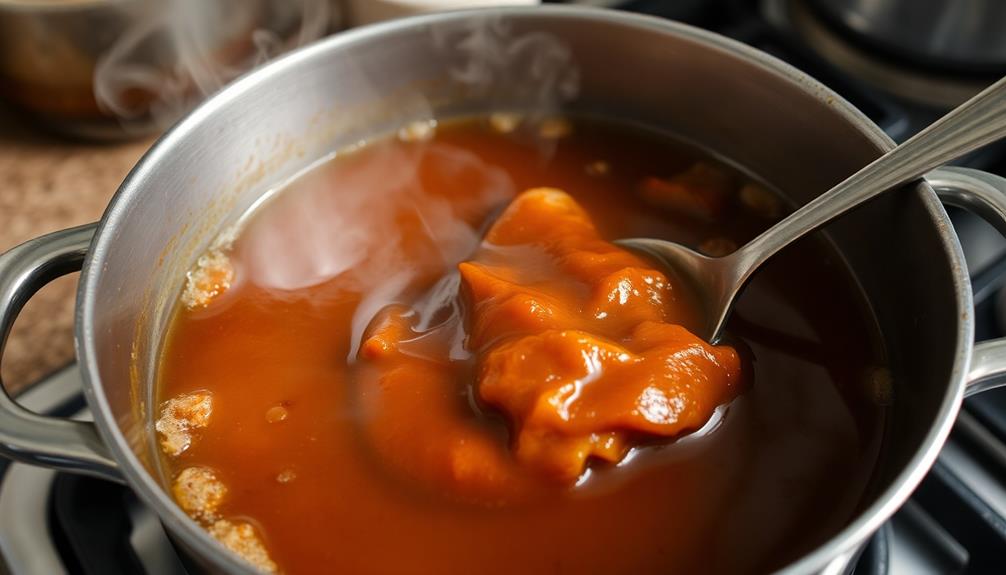
As the meat simmers in the fragrant coconut milk, you'll want to gradually reduce the liquid until it reaches a thick, velvety consistency. This step is crucial for developing the rich, complex flavors of the rendang.
Simmer the mixture over medium-low heat, stirring occasionally, allowing the liquid to slowly evaporate. As the level goes down, you'll notice the sauce thickening and becoming more concentrated. Be patient, as this process can take up to an hour or more.
The goal is to achieve a thick, clingy sauce that coats the meat beautifully. Keep a close eye, adjusting the heat as needed to prevent scorching.
Once the liquid has reduced by about half and the sauce has a luxurious, almost jam-like texture, you'll know you've reached the perfect consistency. This gradual reduction concentrates the flavors, resulting in a rendang that's remarkably tender and bursting with aromatic spices.
Step 5. Garnish With Toasted Coconut

Toward the end of the rendang's cooking, toast some fresh coconut flakes to add a lovely crunch and nutty aroma.
Simply spread the coconut flakes on a baking sheet and pop them in the oven for a few minutes. Keep a close eye on them, as coconut can burn quickly.
Once the flakes are lightly golden, remove them from the oven and let them cool slightly.
Sprinkle the toasted coconut over the top of the rendang just before serving. The contrast of the tender meat and the crisp, nutty coconut is simply delicious. The coconut also adds a nice textural element to the dish.
For an extra special touch, you can toast the coconut in a dry skillet over medium heat, stirring frequently, until golden brown.
This method allows you to keep a closer eye on the coconut and ensure it doesn't burn.
Garnishing the rendang with toasted coconut is the perfect finishing touch, elevating the flavors and creating a truly memorable dish.
Final Thoughts
Rendang, the iconic Malaysian dish, has captured the hearts and palates of food enthusiasts worldwide. This rich, fragrant, and tender meat stew is a true culinary delight that deserves all the praise it receives.
As you savor the last bites, you can't help but feel a sense of satisfaction and wonder at the depth of flavors that have unfolded on your tongue.
The final thoughts on rendang are that it's a dish that truly embodies the essence of Malaysian cuisine. From the careful selection of spices to the long, slow cooking process, every step is a testament to the culinary traditions of this vibrant country.
Whether you're enjoying it at a local hawker stall or recreating it in your own kitchen, rendang always delivers an unforgettable dining experience.
Frequently Asked Questions
Is Rendang a Vegetarian Dish?
No, rendang is not a vegetarian dish. It's a spicy meat stew, typically made with beef or other types of meat. The dish contains ingredients like coconut milk, spices, and aromatics, but it's not suitable for vegetarians.
Can I Substitute Beef With Another Protein?
You certainly can substitute the beef in this dish with another protein. Consider using chicken, lamb, or even tofu or tempeh for a vegetarian version. Just be sure to adjust the cooking time accordingly.
How Long Can I Store Leftover Rendang?
You can store leftover rendang for up to 5 days in the refrigerator or up to 3 months in the freezer. Properly storing your leftover dish will ensure its flavor and texture remain fresh.
Is Rendang Gluten-Free?
Yes, rendang is typically gluten-free. The dish is made with ingredients like coconut milk, spices, and meat, without any wheat-based products. As long as you ensure there are no hidden gluten sources, you can enjoy rendang as part of a gluten-free diet.
Can I Make Rendang in an Instant Pot?
You can certainly make rendang in an Instant Pot! The pressure cooking feature helps tenderize the meat and infuse the flavors. Just be sure to adjust cooking times and follow a recipe designed for the Instant Pot.

